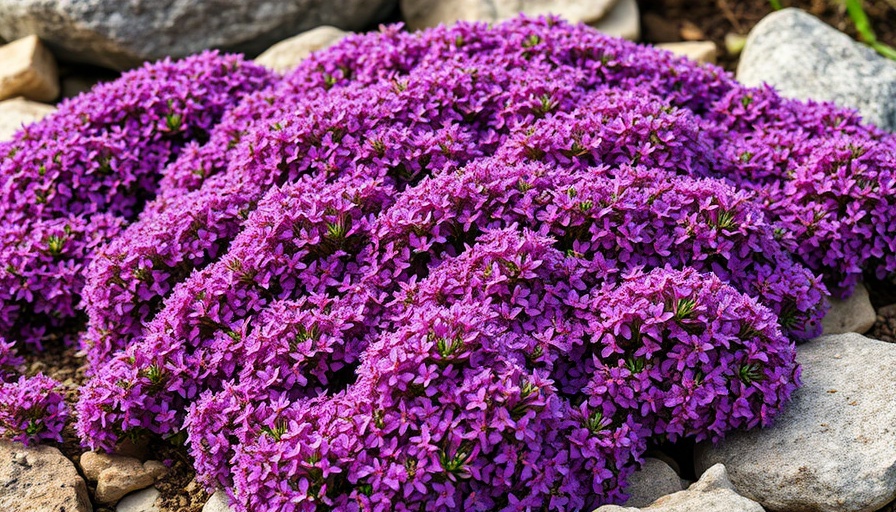
Discover the Magic of Creeping Thyme for Your Garden
Creeping thyme (Thymus praecox) is not just a beautiful addition to any garden; it’s also a multifaceted ground cover that thrives under various conditions. With its lusciously fragrant purple flowers and ability to withstand light foot traffic, this aromatic herb is perfect for planting between stone paths or as a colorful lawn substitute.
The Benefits of Choosing Creeping Thyme
One of the primary advantages of creeping thyme is its ability to act as a living mulch. It provides a natural barrier against weeds while conservatively retaining moisture in the soil. This means fewer chemicals and less water are needed in your garden, aligning perfectly with sustainable gardening practices. Its drought-resistant nature makes it a superstar for urban gardeners and those in warmer climates.
Implementation: How to Successfully Grow Creeping Thyme
Growing creeping thyme is straightforward. Start by selecting a well-draining, sandy soil with a slight acidity to moderate alkalinity (pH 6.0-8.0) for optimal growth. Creeping thyme does best in full sun, so pick a spot that receives plenty of direct sunlight. Space your seeds about 1 inch apart and plant them just below the surface – ideally at a depth of 1/16 inch for seeds, or at the container’s depth for young plants. Water them moderately, as this plant prefers a low to moderate hydration level.
Seasonal Joy: How Creeping Thyme Enhances Garden Aesthetics
Imagine stepping into your backyard in summertime, greeted by the delightful aroma of blooming creeping thyme. This ground cover flourishes under warm sunlight, producing waves of lavender-pink flowers that attract butterflies and bees, adding life to your outdoor space. Not only does it increase biodiversity, but its attractive appearance can elevate your garden's overall aesthetic.
Beyond Looks: Eco-Friendly Benefits of Creeping Thyme
Creeping thyme is more than just an ornamental choice; it plays a critical role in supporting pollinator populations, making it an excellent option for those passionate about gardening with a purpose. By incorporating this ground cover, you promote the health of local wildlife, aligning with broader eco-friendly and organic gardening practices.
Best Uses and Companion Planting Ideas
Creeping thyme can be used in numerous landscaping scenarios: as a border plant, filling gaps between stones, or ground cover in rock gardens. It pairs beautifully with other plants such as roses, which appreciate the support from lower herbs to elevate their blooms. For vegetable gardeners, consider planting it alongside peppers and tomatoes; thyme’s pest-repelling qualities help keep common garden pests at bay.
Caring for Your Creeping Thyme: Essential Maintenance Tips
Maintenance of creeping thyme is minimal, making it perfect for gardening enthusiasts who desire beauty without the burden. Regularly check for weeds and remove them to prevent competition for nutrients. While thyme is resilient, occasional pruning can encourage healthier growth and flowering.
Conclusion: Why You Should Start Growing Creeping Thyme Today
Creeping thyme offers a lovely combination of beauty, sustainability, and functionality, making it a fantastic choice for every gardener. Not only does it add vibrant color and delightful fragrance, but it also supports wildlife and reduces water usage. If you haven't yet added this delightful herb to your garden, now is the perfect time to experience its many benefits!
 Add Row
Add Row  Add
Add 




Write A Comment